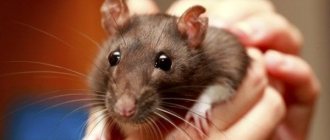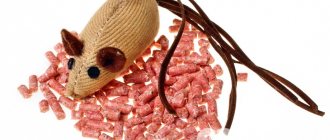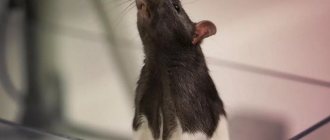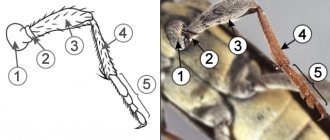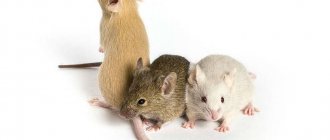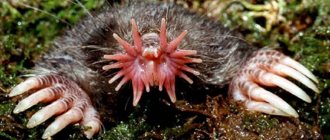Why does a rat have a bald tail?
Most people have the misconception that a rat's tail is completely hairless.
If you look carefully, you will notice that its surface consists of many tiny hairs. By touching it, you can make sure that it is not at all slippery and bald. On the contrary, a little rough and warm. The rat's tail has this appearance due to the evolutionary process. Rodents are excellent swimmers, and their tail with a smooth surface helps them comfortably cross bodies of water, so they often live near water. If we think logically, then a rat with a bushy tail would always have a lot of problems due to contamination of this part of the body, because rodents crawl in a variety of places.
Bone tissue injuries
The most common injury is a broken tail in a rat, which occurs as a result of being pinched by a cage door. It is not uncommon for owners or family members to unintentionally step on a rodent.
Veterinarians are confident that if a rat breaks its tail and is examined by a specialist in time, breeders can rest assured. Typically, the broken part must be amputated, but in rare cases the animal may chew it off. If a wound is found on the tail, the area is treated with a weak solution of potassium permanganate.
If the owner accidentally steps on a rat and the animal is injured, it is important to act quickly:
- place the animal on a flat surface;
- if a rodent has broken its spine, it will drag its hind legs;
- when an animal drags one paw, then we are talking about a fracture of the limb.
After initial measures, it is necessary to take an x-ray of the rat’s paw fracture so that the doctor can make an accurate diagnosis.
Balancer
Another interesting fact about the rat and its tail is its ability to balance. After all, it will not be difficult for a rat to climb a vertical surface or crawl along a branch or wire. And in all these situations, her tail comes to her aid. It is he who allows the animal not to fall and maintain its balance, performing the function of an invisible hand. The length of the rat’s tail is of particular importance in this case: the longer it is, the more confident the animal feels.
Now you know about the value of this rat’s dignity, which not only adorns the animal, but also saves the animal from danger.
Source
Location of internal organs
The anatomical atlas also informs about what the general arrangement of the internal organs of a rodent looks like.
This information can be obtained visually by performing an autopsy on the rat. Once the procedure begins, the diaphragm is the first to open, separating the thoracic and abdominal areas.
Directly below the diaphragm is the rat's liver. It is distinguished by its bright red color and partially covers the stomach, which is pear-shaped.
Below, the bulky mass of the intestinal tract opens. It is covered by the omentum - an organ for the accumulation of animal fat.
A characteristic feature of this type of rodent is the absence of a gallbladder. Bile is supplied through a duct from the liver directly to the duodenum.
The vascular system is clearly represented by the inferior vena cava for the outflow of blood to the heart from the peritoneal organs. The aorta, which is necessary for a complete blood supply to the hind limbs, is also found there.
When examining the chest cavity, a pair of pink lungs and a heart with large vessels are immediately visible. The lungs hang loosely on the bronchi, rather than being attached to the chest. Deeper is the esophagus, which connects the pharynx to the stomach.
Black rat
Black rat
This type of rat is no less common. Black rodents live in Europe and Asia; they are also found on the American, Australian and African continents.
Black rats are inhabitants of megacities. They prefer to live on the upper floors of high-rise buildings. Very often, mammals can be found on livestock farms. Favorite habitats for animals in the private sector include attics. For this reason, they began to be called roof rats. Animals are very inquisitive, they are in constant motion, exploring new territories.
Under natural conditions, black rats live in forest areas, constructing nests from small branches and grass. They can also settle on low-growing trees, feeding on plant foods, nuts, cereal grains or sunflower seeds. The animals do not disdain worms and mollusks. Animals do not dig holes on their own, but they are easily able to take over the abandoned shelter of any small animal.
Not everyone knows what color rats of this species are. It is surprising that the color of the rodent’s fur, which has a metallic sheen, can vary from black to light brown. The abdomen of the animal is often ashen or gray in color.
But in terms of reproduction, black rats are not as prolific as their gray counterparts. They do not breed in the winter season, and they have fewer cubs per litter.
Intelligence difference
If we compare the intelligence of two types of rodents, then mice are much inferior to rats, which are more intelligent. Scientists equate their intelligence to that of cats and even dogs. These are careful animals.
They assess the area they intend to settle in, study it for potential dangers, and leave if they see a serious threat. Other amenities are also important to them: they know how to assess the temperature of the room and the quality of food. If the food seems dangerous to them, they will not take risks.
Rat
Mice are not capable of such actions. They assess the territory worse and easily eat poison. Small rodents are more likely to become victims of predators because they leave behind many traces and cannot identify potential danger.
The difference in intelligence is also noticeable in the fact that mice gather in packs less often, they do not have a clear hierarchy and defined roles. Rats always live together. Each individual in the pack has its own responsibilities. For example, before settling into a new territory, a small group of rodents must explore it. If she seems safe to them, then the rest of the pack will follow.
Rats
Important! Rats are very aggressive. They often attack mice and kill their relatives if they feel threatened by them. Sometimes they attack weakened individuals if the flock lacks food.
Rats easily recognize danger and try in every possible way to avoid it. When they see a predator, they run away to a previously found shelter. Mice act chaotically, rushing around in circles, so they get caught more often.
Functions of the tail
Anatomically, a rat's tail is an extension of the spine. The shape of the tail resembles a cone - the middle part has small bones that are surrounded by tendons, which, in turn, are covered with skin. The tail along its entire length is penetrated with blood vessels.
- Balancing - thanks to the presence of a long tail, the rat can easily move along narrow vertical surfaces, such as a rope or wire. The tail controls balance, thereby allowing the rat to maintain balance. In addition, with the help of its tail, the animal can grab onto something, roll over onto its paws from its back and stand on its hind legs. The longer this process, the more dexterous and confident the rat’s actions.
- Thermoregulation - inside the tail, as mentioned above, there are many blood vessels. When a rat is hot, the blood vessels dilate, cooling the blood passing through them. Thanks to this process, the rodent's overall body temperature decreases. Conversely, when a rat experiences cold, the blood vessels constrict, causing blood to circulate more slowly, maintaining body temperature.
Important! In cases of real danger, the tail can shed its skin - this is a natural defense. The peeled skin remains with the enemy, giving the rat a chance to escape
Unfortunately, the rat's tail does not recover, like that of lizards, and in the future the animal has a not entirely attractive appearance.
Tail Features
Everyone knows that when in danger, a lizard can leave its tail in the enemy’s mouth and run away, and then regrow it. Rats also have the same feature, but they cannot grow their tail. When a predator attacks a rodent and grabs it by the tail, its skin is removed, exposing the spine bone. Roughly speaking, only the “skin” from the tail remains in the enemy’s mouth, and the spine itself is unharmed. But over time, the bone dries up and falls off, after which the rat continues to live with the “stub.” So this ability is one for her entire life.
By the way, such tailless rats do not live long . As mentioned above, the tail helps regulate body temperature and maintain balance. Without it, the rat loses its main trump cards and becomes easy prey even for weak predators. It's only a matter of time before she gets caught. If there is no tail, then the lifespan of these rodents can be greatly reduced.
A similar situation can happen at home. If you have decorative rats, then never grab its tail for fun. If she gets scared and “throws it away”, then nothing will grow in place of the stub, and the rat will remain disabled for life. However, if this happened by accident, or the tail was pressed down by something, then you just need to stop the bleeding, treat the injury site with chlorhexidine and cover it with a bandage. Then you just have to wait.
Rat. Part 1, anatomical
Rats, like cats, can “stretch.” But the reason is somewhat different - in rats the spine is actually a couple of vertebrae longer. And the legs are shorter relative to the body, which is why the rat initially looks elongated.
The odontoid process of the second cervical vertebra (axial) has a conical shape. This allows the first vertebra (atlas) to rotate not only about the axis, but also in other directions. This skeletal feature provides rats with exceptional head mobility, which allows them to defeat even larger opponents.
Thanks to its powerful hind legs, the rat can jump up to a meter in height. The front legs are much smaller. To cushion them when jumping, rats have a structural feature: on the spinous process of the second thoracic vertebra there is a joint connecting it with a triangular bone plate directed forward. From below, tendon cords are attached to this plate, extending to the first thoracic and four posterior cervical vertebrae. When landing, this “structure” springs and absorbs the impact. Nutria has the same feature.
Rats have a visual angle of 160′ and are nearsighted. A rat can see clearly no further than a meter, so if you stand quietly in the opposite corner of the room and don’t move, you don’t exist for the rat. The animal does not see in the red spectrum, but distinguishes ultraviolet light; in general, the world for a rat is gray-blue-green, like for a dog.
How can one live with such vision? That's how. The rat constantly turns its head, and its eyes move independently of each other, and they always move in the opposite direction relative to the head: if the rat lowers its head, the eyes look towards the tail, when the rat raises its head, the eyes become “in a bunch”, when tilts his head - the lower eye looks up, and the upper eye looks down. The difference in the direction of the eyes is up to 40′ in the horizontal plane and up to 60′ in the vertical. Thus, the rat sees the surrounding space in fragments.
Rats have a unique hearing; they hear the slightest rustle, as well as ultrasound. But they do not distinguish pure tones. A rat may not hear a wailing siren, and ultrasonic rodent repellers do not work on them because their sound is quite acceptable to rats.
Rat noses have twice as many olfactory receptors as humans, and they smell through each nostril separately. In just fifty milliseconds, the source of the odor is identified and analyzed.
Rats make whistles in the ultrasonic range. Moreover, they whistle not with their lips, but with their throats and are able to suddenly change the frequency of the signals. Rats have a rich “vocabulary” of screams with special intonations and meanings. Scientists have found that rats are even capable of laughing: when “laughing,” the rat emits a series of identical ultrasounds.
Rats are the only living creatures that can sense X-rays. At the same time, they can withstand very high levels of radiation.
The tail is almost equal in length to the body, it is covered with fine bristles and scales, the tail is rough and hard to the touch. The tail has two functions - thermoregulation and balancing. Tendons run along the tail, thanks to them the rat can cling to its tail.
When a predator attacks a rat and grabs it by the tail, the skin is removed, exposing the spine bone. Over time, the bone dries out and falls off, after which the rat continues to live with the “stub.” A tailless rat, as a rule, does not live long. So do not grab or lift your pet rats by their tails, they may come off!))
The second part will be devoted to the “service” of the rat to man
source
Breeds of decorative rats
Breeds of decorative rats
Standard are the most popular types of decorative rats with smooth and glossy fur. The standard rat is a rather massive animal with a long body. Body length is about 240 mm. It weighs 500 g. The tail is long, about 200 mm, thick at the base, gradually tapering towards the tip. The ears are wide, round in shape, squat, but not too large.
Rex are rats with dense and curly fur, which is less shiny than standard ones and coarser. Another peculiarity of the rex's coat is that the number of guard hairs in it is greatly reduced, and the animal's whiskers are slightly shorter and have a strongly curled appearance.
Tailless - rats that do not have a tail. This variety is the result of a mutation. The first tailless rat was bred by an amateur in 1983. Most of them do not suffer from the lack of a tail. The body shape of animals of this species is somewhat different. Tailless rats should have a pear-shaped body and no vestiges of a tail.
Hairless - hairless rats. The less hair a rat has and healthy, bright and soft skin, the better. It is quite acceptable to have fluff above the eyes, on the wrists and ankles, in the groin area and on the cheeks. But such fluff should not be excessive and disturb the picture of a naked animal.
Satin - the fur of this breed of decorative rats is thinner, shiny and elongated. This variety has the same body structure as individuals with regular hair. The hair of satin rats is somewhat elongated, smooth, with a deep shine. The wool is dense and very pleasant to the touch. The shine of the coat is the main distinguishing feature and advantage of this variety of decorative rats.
Dumbo - rats with large ears. This species was bred in California in 1991. This species of rat got its name from the elephant from the Disney cartoon. These rats are distinguished by their low-set and more rounded ears. The head of these animals is wider and smoother, compared to other breeds of decorative rats. The muzzle is relatively sharp. With its pear-shaped body shape, this species is similar to tailless rats, but has a shorter body and a long tail.
A unified standard for varieties (breeds) has not yet been developed for Russia, therefore, along with the generally accepted varieties, there are also other breeds of decorative rats:
Downy, Fuzz (Fuzz)
Fuzz is a rat with fine downy hair that forms a translucent coat. The hair is thin, sparse, short. There are no guard hairs. The mustache is curly and short. Disadvantages: lack of “fluff” on large areas of the skin, presence of spine.
Double Rex
The Double Rex is a rat with double hair. The coat is very short, so that the skin shows through, but like the Rex, it is twisted into a spiral. Hard guard hairs are distributed interspersed with soft, short and thin downy hairs throughout the body. Double Rex sheds regularly. As a result, some areas of the body are either temporarily devoid of hair or are covered only with a thin layer of downy hair. The color and color of the coat can be any, and the mustache is short and curly.
Sphinx - see Hairless hairless rats (AFRMA - Hairless)
The Sphinx is a rat that is completely hairless. In this case, the animal’s mustache is completely absent, and the skin is clean, smooth and folded. Rats can maintain different pigmentation until they reach the age of four months, in accordance with the standards of markings and colors. With age, the skin becomes completely pink as its pigmentation is lost. Male Sphynx rats have thicker skin than females.
After certain breeding work, some breeds were crossed with each other. As a result, various hybrids of decorative rats appeared: such as Dumbo Sphinx, Dumbo Double Rex and others.
The hair of a rat can be colored in a wide variety of colors: black, white, orange, gray, blue, dark blue, chocolate, brown, beige, red and others. Each coat color has its own eye color (one or more colors). Thus, blue rats have ruby-colored eyes, while rats with black fur can only have black eyes. White rats can have either red or black eyes.
In addition to colors (colors), you can note a variety of markings and markings - patterns: hood, husky, Himalayan, solid, Siamese and others.
So we found out what breeds of decorative rats exist in the world!
Read with this
External structure of a rat
Upon external initial examination, a significant amount of hair can be noted throughout the body. This is a characteristic of this class of mammals. Main functions of wool:
- thermal insulation;
- involvement in touch;
- protecting the skin from damage.
The animal's head is large in size relative to the body. The muzzle area is pointed, the rear section is adjacent to the short neck. The rat skull includes 3 sections:
At the end of the muzzle there are vibrissae - bristles intended for touch. Rats are characterized by the presence of a nictitating membrane and a red glow in the eyes.
Experts divide the rodent’s body into 3 sections:
- dorso-thoracic;
- lumboabdominal;
- sacrogluteal.
The tail of rodents is thick, accounting for 85% of the total body length. The female has a longer tail. The surface is covered with scaly rings and yellow fat. Instead of fur there are bristles.
Female animals are characterized by 6 pairs of nipples, two of which are in the armpits, one on the chest and three on the belly. Outside of pregnancy, they are hidden by thick hair. The sex of the rat is determined by examining the rear part: in females the rump has the shape of a triangle, while in males it is shaped like a cylinder.
Mature males can reach a weight of 400 g. Females are much smaller.
The animal's skeletal system consists of bone and cartilaginous parts, and includes 264 bones of various shapes and sizes. The skull has an elongated shape. There are several sections of the spine:
The vertebral part in the rat skeleton is characterized by more than 2 dozen discs.
Why do rats need a tail?
The rat's tail is a subject of great controversy. The question of its need and functional properties still arises today.
However, given the fact that there is nothing superfluous in nature, this means that this appendage is of no small importance for the animal. This article will tell you why a rat has a long tail.
Scientists know more than 60 species of rats, and most of them have a tail length that matches the rodent's body size. Even small rats have a long tail. Many people believe that a rat's tail is hairless. However, this statement is not entirely true: if you look closely at the appearance of the rat, you will notice that the tail is covered with small bristles that have the same color as the animal itself. The hairs are especially clearly visible against the fleshy background of the skin of white and black rodents. Below you can see what a rat's tail looks like in an enlarged photo.
There is another myth according to which the tail of a rat is noticeably cold and slippery. This opinion is also incorrect: the surface layer has no mucus at all, but on the contrary, it is quite rough. It consists of small scales tightly adjacent to each other. The extension of the spine can be cold if the animal is frozen.
Why do animals need a tail?
Often, young children, just beginning to explore the world around them, ask their parents the same question: “Why do animals grow tails? “It should be noted that not every parent is able to give a clear and truthful answer to this simple question.
Usually the answer is banal phrases about how this is how it works. But inquisitive little minds are rarely satisfied with such a general answer and continue to look for more specific reasons.
Especially for these inquisitive kids, as well as for the peace of mind of their parents, we inform you: there really are such reasons.
Tails grow because without them, many animals would feel “as if they had no arms.” With the help of the tail, animals can communicate and express their emotions, find new friends and scare away opponents, defend and attack, keep warm, give danger signals, climb trees, steer their own body when running, jumping, flying or swimming, maintain balance or just have fun. Tails play a very important role in the lives of most animals.
Rat tail or pro-Tail.
This part of the rat causes the most heated debate and the most conflicting opinions. Some sing odes to the rat's tail, while others become hysterical at the sight of it and run across to another part of the street. But it’s true, such a beautiful animal is a rat, and such an incomprehensible thing is its tail. Why does she need him?
We, the rat breeders club, very often go to various events and promotions, together with our pets. So that people can communicate with these animals personally and learn more about them. There are always people who are afraid or do not like rats. To the question: “Why?” our interlocutors make a terrible grimace and say: “Well, it’s a rat! She has such a disgusting bald tail! At such moments, it is “a matter of honor” for every rat breeder to dispel the myths and prejudices of people. There are actually several myths about the rat's tail.
- “The rat’s tail is bald” - this is actually not true. Of course, a rat is not a squirrel, it does not have a gorgeous fluffy tail. But if you look closely at the rat’s tail, you will see soft short hairs, the color of the main color of the rat itself.
- “A rat’s tail is slippery and cold” - that’s what those who have never touched it say. A rat's tail simply cannot be slippery. It is covered with “scales” that are pressed against each other, and there is no mucus on it. As for the temperature, it depends on the body temperature of the rat. And if it becomes cold, then it’s time to warm the rat.
- “The tail of a rat is poisonous” - well, here we can only laugh and recommend that people who claim this stop watching horror films.
Rat breeders' trip to the Tikhvin orphanage. Photo by Elena Deino https://vk.com/id8979350
Seriously though, its tail helps regulate body temperature. If the rat is very hot, then we can help it by wetting its tail with cold water. And the most important function of the tail is to maintain balance. She uses it when she needs to hold on to something, such as a branch or rope. Or stand on your hind legs for a long time. Well, with its help, turn over from your back to your paws. Holding, grasping, clinging and balancing is its function.
Rats are very clean animals. Being a hunter in nature, a rat is not allowed to have any scent on itself. That's why she washes her beautiful fur coat most of the time. She washes her coat, but still doesn’t reach her tail. There are a lot of neat rats who keep his order. But there are even more rats who forget about it, or are simply lazy. Therefore, caring owners have to wash the rat's tail themselves before exhibitions or important events.
The most important thing to know about a rat's tail is its fragility! If in nature, a rat is caught by the tail by a predator, then a defense mechanism will work. The skin will be removed, exposing the bone (spine) of the tail.
The rat will be able to escape at this moment. But a rat is not a lizard! Her tail won't grow back. The bone will later dry out and fall off, and our animal will live with the “stub”. This, of course, is not very convenient for her, but she is safe
If you accidentally crushed it at home, or picked it up carelessly, and the tail came off, then it is important to stop the bleeding. If possible, treat the tail with chlorhexidine and cover the breakage area with a bandage.
Everything else will work out.
After communicating with rat breeders, people who were previously afraid of rats or tails change their point of view. They begin to perceive rats completely differently. Such people are offered a unique opportunity to get rid of their phobia - to touch the tail here and now. Those who did this get rid of their nightmare forever. And if they don’t fall in love with rats, then at least they begin to respect them. Isn't this wonderful?
source
Character of rats
Rats are pets that love to interact with people and develop strong bonds with their owners. They love to cuddle and climb on their owners, and if you socialize them properly, they enjoy being in the hands of their human. Rats often happily sit on their owners' shoulders or heads, or find them dozing on their owners' laps if given the opportunity. They have also been found to experience emotions in the same way as humans. They can feel loneliness and empathy, which helps guide their social behavior around people as well as other rats.
Rats can be trained to do all sorts of behaviors and tricks. If you like the idea of learning about animal behavior and training but don't have room for a dog, a rat is a great beginner pet. They quickly adapt to clicker training and can be home trained, learn their name, and learn to do almost anything that is physically possible for them.
Rats are relatively easy to care for compared to other pets. They keep themselves clean like cats, although they will rely on you to keep their cage free of contamination. You do not need to bathe or brush them except in special medical cases. You won't have to deal with shedding, and some rats are even hairless.
They also don't tend to bite. While this behavior is always a possibility, it occurs much less frequently in rats compared to other similar pets. If you are looking for a small pet that is suitable for children, a rat may be a better choice than other rodents that tend to bite and are less easy to handle.
Rats don't need large spaces, so you can easily keep your rat happy by living in a small space like an apartment. They do need time out of the cage, but they won't need a yard to roam, so they are much easier to keep than, say, a dog.
Black-tailed rat
The black-tailed rat is another species of the mouse family, the distinctive feature of which is its tail covered with thick hair. Animals are common in New Guinea and Northern Australia. Their habitat is the coastal zone of rivers and other bodies of water, where after the surf, rodents collect food thrown out by the waves. The animals hide in hollows or between thick branches of trees, where females make nests for future offspring. The presence of fur is a distinctive feature of born rat pups. In addition, they mature and grow much faster than their relatives.
Is it possible to pick up a rat by the tail?
Rough actions towards the tail are undesirable. This process is very fragile, and with a careless movement, for example, lifting a rat by it, you can easily break it or tear off the skin. If you need to pick up a rat, grab it under its chest by its body.
In cases where the tail is damaged, you can provide first aid to your pet:
- In case of an open fracture, it is necessary to stop the bleeding; to do this, treat the damaged area with chlorhexidine or miramistin. Peroxide is usually not used on rodents, as it causes unpleasant pain.
- After antiseptic treatment and stopping the bleeding, it is necessary to apply a healing ointment - Levomekol, or a veterinary drug - Terramycin in the form of a spray.
- The wounded area is covered with a band-aid; the ideal option is a band-aid with a bactericidal liner.
Interesting! New breeds of rats - tailless ones - have been developed as a result of fashion. The breed of short-tailed rats is called Manx. Perhaps the animal is not bad aesthetically, but representatives of this breed are susceptible to many diseases, and their life expectancy is shorter than that of their relatives with long tails. Therefore, it is obvious that the tail is a necessary part of the rat’s body.
Thermostat
People have often wondered why rats have a tail. This process has two purposes, which ensures the normal functioning of the animal. The first purpose is to regulate body temperature. The blood vessels inside the rat's appendix are able to expand and allow a larger volume of warm blood to pass through them. The liquid is returned to the rodent’s body already cooled, which helps lower the animal’s body temperature.
Article on the topic: The body of a rat: structural features of the head, muzzle, paws and teeth (photo)
The cycle in the opposite direction occurs when body temperature drops. Therefore, the rat’s tail serves as a kind of thermostat.
Rat without a tail. Almost
This little pig was born among ordinary rats)
They thought the tail would fall off, because there were no vertebrae there, she couldn’t use it, but the baby was already 2 months old)
An option for those who don’t like rats because the “tail is disgusting.” Or maybe someone else has encountered similar anomalies in rats?
No duplicates found
Professor speaking at a conference
-if you cut off the tail of rats after birth for many generations, then the rats begin to be born tailless.
— how would you comment on the case with the hymen?
It was Academician Kapitsa who asked Academician Lysenko at a session of the All-Russian Academy of Agricultural Sciences:
— Did I understand correctly that if you saw off one horn of a cow, and its descendants also sawed off one horn, then in the end one-horned cows will be born?
-Then another question. Why are all women born virgins, and Jews are born uncircumcised?
Manx is the name given to such mutants in rats. You are lucky that your baby is in good health. This usually comes with problems. After all, since there is no tail, there is no part of the spinal cord, the function of the spine is impaired, as a result, problems with walking, problems with defecation and urination.
Breeders usually keep such rat pups for themselves, since it is not good to give away a potentially problematic animal to people.
She’s probably uncomfortable, rats use their tails so much. Don’t others pinch her?
Rats are cool if they're not bald)
No no no! Bald people are the coolest.
Cut it off and sell it like a Chihuahua
Mother Nature loves to play tricks. Still a cutie!
Regular bobtail. Nothing strange.
Just in the hot post above about breeding piglets
Or maybe you shouldn’t engage in breeding without understanding the topic and breeding rats with a mutation in particular?
About tailless rats, I’ll quote from an article on Ra with my relatively “healthy” tailless rat? According to foreign Manx breeders, pups in a Manx litter are “rarely” non-viable and die in the first days of life...”
Are you really willing to condemn your potential offspring to problems with thermoregulation, balance, and a host of other problems for your own amusement?
source
Tailless rats
Among professional rat breeders, the tailless Manx breed is especially valued. Buying such an unusual animal from a nursery can cost 1,500-2,000 rubles. This popularity is explained by the cuteness of the rodent - a rat without a tail looks like a hamster that you just want to cuddle. However, from a genetic point of view, the absence of a tail in a rat is considered a mutation. And most ratologists consider breeding Manx cats to be cruelty to animals. And there are good reasons for such an opinion:
- tailless rats constantly experience discomfort due to the lack of thermoregulation;
- in the absence of a tail, animals have problems with balance;
- As a rule, in tailless rats not only the tail is underdeveloped, but also a number of internal organs (for example, kidneys, bladder, genitals).
As a result, Manx life expectancy is significantly lower than other breeds. If a healthy rat at home calmly lives up to 3 years, then a tailless rodent lives up to a maximum of 1.5-2 years.
Quite often, unscrupulous breeders simply amputate the tails of their pets, trying to sell them under the guise of Manx. It is worth noting that docking the tails of rats can be called an act of brutal violence. Because after such an operation the animals become disabled.
Tips and tricks for injuries
Even the most responsible and attentive owner is sometimes unable to keep track of the animal. If a rat has torn off its skin or your pet has fallen from a height, you should remember simple rules:
- Examine your pet carefully. If the skin is severely damaged or the animal has difficulty moving, you should immediately consult a doctor.
- Find out whether the animal could have been accidentally stepped on to rule out injuries to the spine and limbs.
- Do not forget that minor tissue damage is only visible on an x-ray.
If a rat breaks its leg after falling from a great height, carefully restrain the animal and apply a splint to prevent movement.
In case of fractures, it is important to ensure complete rest and limit movement as much as possible.
When an animal's limbs are broken, the recovery process largely depends on the prompt actions of the doctor and breeder. After being examined by a veterinarian and prescribing treatment procedures, strictly follow the recommendations and make sure that the rodent does not fall again or damage the skin.
Differences in nutrition
Both species are omnivores, but rats and mice can be distinguished by their feeding habits. Both of them are predators. They can attack other animals and insects and eat their meat.
Rats are more aggressive. Wild individuals hunt more often and mainly in packs. But they can attack alone. Small and weakened animals, including mice, often become victims of rats. When there is a shortage of food, rodents also attack each other. More often than mice, they feed on human household waste, so entire flocks often live in landfills.
Rats
Mice eat meat less often. These rodents prefer plant foods. They regularly replenish their supplies with leftover vegetables, seeds, and cereals. But this does not mean that mice will refuse meat. They will eat it with pleasure, but they will not hunt for it.
Mouse
Small rat
The taxonomy of the rat does not end there; its continuation is the small rat. The Pacific or Polynesian rodent is found in the Philippines, New Zealand, as well as the countries of Asia and New Guinea. The habitat of the animal is forest and forest-steppe zones.
Depending on the distribution area, the length of the animal’s body varies. The animals inhabiting the mainland of the continent reach up to 15 cm, small rats living on the islands do not grow more than 11 cm. The weight of the animal is also small: only from 40 to 80 g. The fur of a small rodent on the back is brown, in the abdomen - light tones Its distinctive characteristics also include a pointed muzzle, large ears and short legs. The tail has a length commensurate with the size of the body, and is covered with scaly rings.
The diet of the small rat is very diverse, it includes: seeds, fruits and parts of plants, as well as insects, spiders, bird eggs and tiny chicks.
Small rats reproduce throughout the year; the reproduction process becomes especially active in the summer.
Decorative pets
Rats for those who are embarrassed by the rat's tail.
No duplicates found
A rat without a rat tail is like macaroni and cheese without the cheese.
Like a samurai with a sword, but without a sword.
Here's another breed: Banana rats. Banana rat.
As for me, without tails, rats look stupid, like guinea pigs... On the contrary, I like tails, especially when they wrap around a hand or cling to something)
bitch what confuses me is not their tail, but their giant balls, and how they rub them against people
As the wonderful writer Olga Gromyko wrote:
The tail in a rat is the most necessary part. It is not at all cold, wet and disgusting, as unfortunate people who have never touched this tail claim, but delightfully rough and at the same time velvety, warm
He hangs behind the rat for a reason, but for an important purpose, working at the same time as a balancer and a cling - when the rat runs along a narrow ledge, rope or hand. The rat also knows how to casually swipe souvenirs from the shelf with it, and then look down at the fragments with sincere amazement: “I have nothing to do with it, it’s all him, the prankster!” But for some reason she is very offended when for him she is pulled out of the created harm (like a hole in a pillow)
During use, the tail turns somewhat brown and loses its marketable appearance, so before the exhibition, Severe Minsk Breeders conduct a secret ritual of cleaning it. The tail is soaked in warm water and brushed with the husband’s toothbrush (that’s why the ritual is secret - otherwise it won’t be good!) until it shines. The judges cannot resist such magnificence, and the triumphant breeders take away a bunch of diplomas and rosettes from the exhibition.
Twisting rats' tails is a favorite pastime of rat keepers. If you gather several rats in a bun, their tails will be woven into a braid. You can also lift the rat by the tail - then it will touchingly tuck its hind legs and walk on its front legs. There are few painful endings in the tail, so the rat does not experience much discomfort, being tolerant of the owner’s foolishness. The most chic thing is to make yourself a “mustache” from the tail of a rat sitting on your shoulder, holding it between your lip and nose. This makes an indelible impression on impressionable ladies who accidentally end up at a rat exhibition.
However, pulling a rat's tail should be done with great caution (Severe Minsk Breeders prohibit pulling at all, but this is too great a pleasure to give up). Everyone has heard about the lizard, and some even about the flying dormouse, which leaves the very hind limb in the teeth of the predator, but few people know that a rat is capable of the same meanness
The tip of its tail (more precisely, the last third) is intended by nature itself to be sacrificed to the enemy, so under no circumstances should you catch a rat by it, much less lift it! The skin will come off like a glove, the exposed cartilage will soon dry out and fall off, and the saddened rat breeder will only have to cry on the forum: “The tail has come off, what should I do?!” Unfortunately, they won’t sew it back, and it won’t grow back.
source
Interesting facts from physiology
Veterinarians and biologists, studying the anatomical and physiological structure of the rat, noted a number of interesting facts:
- numerous laboratory studies on rodents are explained by the similarities in physiology between rats and humans;
- the animals lack tonsils and thumbs;
- males have tissue for the formation of mammary glands, but there are no nipples even in their infancy;
- females have a vestigial penis that can be used for urination;
- In rats, the right and left lungs have different structures. The first has 4 beats, and the second has only one;
- rodents have an appendix, which is sometimes confused with a frolicking internal tumor;
- unlike humans and cats, albino rats do not suffer from hearing problems;
- ultrasonic exposure causes discomfort to rodents, but they can easily tolerate it;
- Rodents do not have lips around their mouths. Instead, a folded gap is formed above the lower jaw;
- The male spends 2 seconds on fertilization, so keeping different-sex individuals in the same cage guarantees the presence of offspring.
source
Rat King - truth or myth?
The Rat King is recognized as a rare phenomenon. The tails of several rodents become so tightly tangled that the rats cannot free themselves and untangle them.
Such rats quickly die because they cannot coordinate their actions to obtain food or simply direct movement. Such cases are very rare: throughout the world, over a long period of time, there are only a few dozen such remains. Often these discoveries were made by accident by ordinary people - on their farms, basements or near mills, but despite this, a huge number of myths about such monsters arose, especially in ancient times.
The most interesting thing in these stories is that no one has ever seen such kings live; only rat remains testified to this. To date, there is not a single photo, much less a video, to prove this phenomenon.
Of course, it is difficult to imagine that the tails were intertwined after death, i.e. It is logical that the knot arose during life - the constant bustle of rats could lead to this. A rat can live without food for a maximum of 4 days, i.e. Confused and unable to come to an agreement, such animals are doomed to death.
There is a version about the “fusion” of tails due to cramped circumstances: in a cramped and narrow space, sooner or later the tails will become connected. Or, according to another version, the tails may become tangled due to contamination, food debris, blood or sticky substances sticking the rats' tails together. Another theory is that the tails freeze together when rats try to stay warm in cold weather. In any case, after waking up, the rats try to run away in different directions, only tightening the knot more.
Here are some interesting facts about the common rat's tail. What fact was the most unexpected for you?
What I am a master at is talking incessantly about hamsters. I have three hamsters at home, and my husband has a pet rat. That’s how we live, the six of us eat, the six of us sleep :)
source
